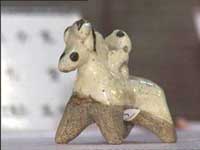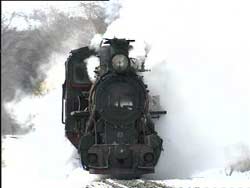Around Harbin 
cctv.com 02-24-2004 10:09
In winter's time, Heilongjiang, China's north most province, is very cold. The average temperature just hovers around something like 20 degree Celsius below zero. But the people here are very warm-hearted and straightforward. And they eat with plate this big.
This is a land that refuses to melt. Everything is on a bigger scale -huge forests, grand rivers and magnificent mountains. It is said that the black soil here, now covered by the white snow, is fertile to the point where you can actually squeeze oil out of it. That may or may not be true, but Heilongjiang is certainly a land bestowed with abundant natural resources, and nurtures a people who are famed for their hospitality and generosity. Our trip starts from Harbin, capital of Helongjiang province, the major hub of northern China. We will make a stop at Acheng, then head to Weihe and eventually wind up in Yabuli, China's top ski resort.
Anyone with a little knowledge of Chinese history will know that the last Dynasty in China was the Qing Dynasty, and it was ruled by the Man People, who came from northern China. Now we are going to visit Acheng, where the Nvzhen people, ancestors of the Man people, first rose to power.
Acheng is famous for the ruins of Shangjing city. More than eight hundred years ago, the Nvzhen, a people who originally lived a hunter-gatherer lifestyle, set up their first capital here. It was called Shang Jing. Its establishment, and the settling of the Nvzhen people, marked the rise of a powerful dynasty, the Jin.
All that's left today is just the ruins of the city walls. The wall's perimeter stretches for 11 kilometers and was an adobe, or mud-brick, structure.
The relatively short-lived, but bright Jin Dynasty ruled from here. They controlled an area of land three times the size of today's France, about four million square kilometers.
At the height of its power, about 100 thousand people lived here, a huge number for the 12th century.
Actually there is not too much to see. But standing in the ancient ruins imagining the city's past glory fills you a sensation of the greatness of time.
Li Yongbo from Acheng Toursim Centre said to us, "the city was a fairly big one at the time. It was the political, economic, cultural and military center of Northeast Asia. The city was known widely, and was just as prosperous as today's Hong Kong. It had plenty of contact with Russia and other countries in the Far East. It was full of merchants and political figures."
It's believed there are many layers, other cities under this city. In a place like this, if you dig deep enough, you are bound to come up with treasures and antiques that would make you very rich. But some people have already done that and put them in a museum over there.
A couple minutes away from the ruins you'll find the Jin Shangjing Museum. The Museum houses around 10 thousand antiques and fragments of history, mostly from the Jin Dynasty. Here you find what鈥檚 left of a people, with a reputation of ferocity, who rose from a life of hunting and fishing into a successful and dominant civilization. Amazingly, they did this within a matter of forty or fifty years. The Jin dynasty even had its own currency, and was among the first civilizations in the world to use bank notes.



The most valuable item in the Museum is a sitting dragon made of bronze. After roughly one hundred years of grandeur, the dynasty declined under double attacks from the Han people and Mongolians.
30 Half an hour drive from Acheng, the hunting grounds of the Nvzhen people still remain in the mountains.
But their hunting grounds at Yuquan still remain in the mountains, half an hour's drive from Achen. At the Yuquan hunting ground, the best hotel is called Hunter鈥檚 Camp. The wood-structured building is an octagon, drawing inspiration from the Yurt-like tents of the famous Nvzhen General Jin Wuzhu, who once camped here.
Sitting deep in the mountains, the Hunter's camp is certainly not a star hotel, but it can keep you warm and rested in the evening, ready for a day's hunting.
The Chinese government banned hunting years ago to protect China's wildlife. Now there are only a handful of grounds that permit you shoot at animals. Remember, you are hunting in the royal grounds.
This is where many famous Nvzhen emperors and generals once hunted. Such as Wanyanaguda and Jinwuzhu. As I understand it, it's more of a game reminiscent of the past, as not many people in China are shooters these days. My hunting guide Duan Ximin says that in old times in the mountains the best season to hunt was winter. At that time animals leave traces, such as footprints and droppings on the snow which makes them easier to track.
Back when the Jin ruled this land, the kings and generals would also go into the mountains on horses, but they used bows and arrows of their own, while we could rent shot guns.
Hunting guide Duan Ximin told us, "After you load your gun, you must pay special attention. Make sure you aim tight and measure the distance right. If it's too far away you won鈥檛 get it. Don鈥檛 fire until the distance is right."
Well, hunting is such an exciting word until you are confronted with the very real responsibility of handing out death sentences.
You might opt not to pull the trigger, but don't miss the performance offered by Shamans at the hunting ground. The Shaman was the spiritual leader, a small group or tribe's connection to the spirits that they believed ruled all aspects of their lives. This belief was shared by many ancient tribes in this part of the world, including the Nvzhen people. Such a type of religion is known as animism. Followers worship animals, the sun, the moon, and the elements.
The old man told me that the veil on his face is a veil between god and human. It's purpose is to prevent people from recognizing the Shaman as someone they are familiar with in the everyday life. A Shaman must be mysterious to retain his sense of power over that which cannot be seen, felt, or controlled by ordinary humans. The veil is device to create mystery and worship.
It's not an easy job. You have to dance with an outfit of 20 kilograms. My old hunter guide invited me to his home for his granddaughter's birthday. Though still a fortnight before the Spring Festival, or Chinese New Year, people had already started preparing the festival's symbolic food, dumplings. In this part of China, they don't even need refrigerators to keep the dumplings cold, the frozen air outside provides the service for free. Here I tasted the best dumplings in my life.
From Acheng, we head further east, towards the well-known ski resort of Yabuli. Before we get there, we made a little detour to stop at Weihe, a forestry station.
It鈥檚 rail is different from what we usually see. It's very narrow, only some thing like 768 millimeters wide.
Despite all my imaginings before I arrived, the train entrances me at first sight. It breathes, hums and quivers its' way along the rails through the leafless forests. Winter is the best season as you get better chance to see the steam. Each year many steam locomotive fans gather here for some train spotting. Some took quite a long journey.
The steam engine train here in Weihe is among the earliest its kind in China, built in the early eighteenth century. It's not very difficult to chase, with a speed about 36 kilometers per hour.
From Weihe, we head for the last stop of the trip, Yabuli. Yabuli enjoys the reputation as the most well-facilitated ski area in China today. You don't have to bring anything, the resort has several rental shops that cover all your needs, from goggles to fashionable ski wear, gloves, and the essential skis and snowboards.


Yabuli has a number of separate ski resorts and centers, and I went to one called Windmill Ski Center. The center has a total of 13 runs, five of them for the beginners and four of them black diamonds. The total length exceeds 30 kilometers, and the biggest vertical distance for a single trail exceeds 800 meters.
For beginners like me, the ground looks very daunting. Thankfully, Yabuli has over one hundred ski instructors, and several of them are former athletes who hold gold medals from national competitions. Some of them speak Japanese, and some English.
Challenging, relaxing, risky. The sport of skiing can also be exhausting. On top of the mountain there is a cafe where you could have a cup of hot tea and stretch your legs.
For those who are not satisfied with regular ski runs, they could try their skills at the professional runs in Yabuli Ski Resort. This is where professional skiers train themselves.
Yabuli is about 200 kilometers from Harbin. It has road and railway connections. Harbin-Yabuli is about 3 hours drive.
The best season to ski in Yabuli is between November and March. Snow period is 170 days and snow season is 120 days. Average snow depth is 20-50cm on the lower part of the mountain, 100cm at the top of the mountain.
The most fancy and expensive place you can stay in Yabuli is the Windmill Villa, but budget travelers can also find more modest accommodation.
Yabuli is also where the winter games is held each year. When there are no games, it's where national athletes train themselves and it's also open to the public. Of course it's not for beginners like me, but we can at least take a look.
The chair-lift we are on now serves both tourists and professional ski athletes. This is the place for the real daredevils. The steep slopes and the hard snow crest here look pretty intimidating, nearly one thousand four hundred meters above sea level. If you want to try your skills here, one thing you might need to know is that the icy snow here is much harder than that of standard recreational runs. That is to ensure fair play, to create a less changeable environment for the athletes to compete equally on.
The harsh environment also makes the place an ideal training base for scientists who plan to explore the South Pole. China's Antarctic Research Team took acclimatization and training courses here before going South.
In 1996, these trails welcomed athletes from all over Asia, as Heilongjiang hosted the third Asian Winter Games. Dozens of national and provincial winter games have been held here.
In our short trip around Harbin, we've visited the ruins of a city, a hunting ground, seen steam engine train still in service and lastly, a wonderful ski resort. So, if you are looking for something adventurous, nostalgic, or challenging, come to Northern China, better in wintertime.
Editor:Zhang Source:CCTV.com